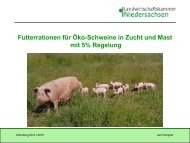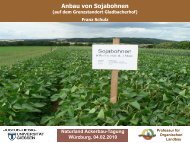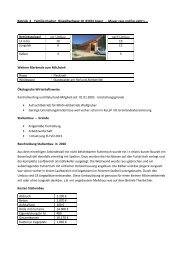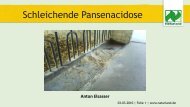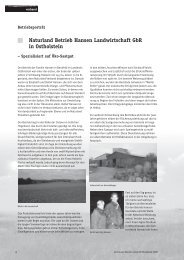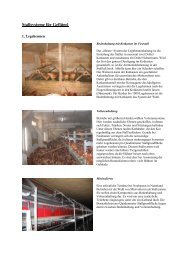Organic Farming in the Tropics and Subtropics: Hibiscus - Naturland
Organic Farming in the Tropics and Subtropics: Hibiscus - Naturland
Organic Farming in the Tropics and Subtropics: Hibiscus - Naturland
Create successful ePaper yourself
Turn your PDF publications into a flip-book with our unique Google optimized e-Paper software.
II Special section: <strong>Organic</strong> <strong>Hibiscus</strong> Cultivation<br />
2.6.2. Pests<br />
<strong>Hibiscus</strong> is extremely susceptible to nematode <strong>in</strong>fection. O<strong>the</strong>r damag<strong>in</strong>g organism<br />
do not generally play an important role. Direct measures to reduce <strong>the</strong> number of<br />
nematodes <strong>in</strong> <strong>the</strong> soil are not usually very successful, which means that an<br />
<strong>in</strong>festation must be avoided as well as possible by use of a suitable crop rotation<br />
system. Studies <strong>in</strong> Tanzania have shown that beetles that w<strong>and</strong>er onto <strong>the</strong> hibiscus<br />
plot can cause significant damage. The hibiscus crops can be protected aga<strong>in</strong>st this<br />
by plant<strong>in</strong>g an additional strip of Okra (<strong>Hibiscus</strong> esculentus) around <strong>the</strong> field.<br />
2.7. Crop monitor<strong>in</strong>g <strong>and</strong> ma<strong>in</strong>tenance<br />
2.7.1. Weed management<br />
Measures used to regulate <strong>the</strong> growth of weeds are largely dependent on <strong>the</strong> site<br />
conditions, as well as <strong>the</strong> type of cultivation system. The plants develop slowly at<br />
<strong>the</strong> beg<strong>in</strong>n<strong>in</strong>g. If <strong>the</strong> crop is sown directly from seeds, <strong>the</strong>n till<strong>in</strong>g of tall-grow<strong>in</strong>g<br />
weeds <strong>and</strong> grasses may be required once or twice, yet as soon as <strong>the</strong> crop is fully<br />
grown, no fur<strong>the</strong>r weed<strong>in</strong>g is necessary.<br />
2.8. Harvest<strong>in</strong>g <strong>and</strong> post harvest treatment<br />
Harvest<strong>in</strong>g commences once <strong>the</strong> calyxes have reached an optimum size. This po<strong>in</strong>t<br />
is generally reached shortly before <strong>the</strong> seed capsules are ready to open, 15-20 days<br />
after blossom<strong>in</strong>g. The fruit is separated with <strong>the</strong> calyx petals manually, ei<strong>the</strong>r by<br />
h<strong>and</strong>, or with a knife. Afterwards, <strong>the</strong> seed capsules need to be carefully removed<br />
from <strong>the</strong> calyxes. Round, sharpened metal tubes can be used for this, to cut away<br />
<strong>the</strong> seed capsules at <strong>the</strong> base, <strong>and</strong> remove <strong>the</strong>m.<br />
F<strong>in</strong>ally, <strong>the</strong> water-logged calyx petals are dried out <strong>in</strong> <strong>the</strong> sun, which should be<br />
performed as quickly as possible. The dry<strong>in</strong>g process must be concluded as rapidly<br />
as possible, o<strong>the</strong>rwise, <strong>the</strong>re is risk of an <strong>in</strong>fection of mould fungi. Suitable dry<strong>in</strong>g<br />
areas <strong>and</strong> methods (e.g. solar dryers) should especially be made available <strong>in</strong><br />
regions where it can ra<strong>in</strong> dur<strong>in</strong>g <strong>the</strong> harvest.<br />
The harvest must be stored <strong>in</strong> a dry place, protected from light <strong>and</strong> well-ventilated.<br />
Measures to protect aga<strong>in</strong>st storage pests should be adopted when stor<strong>in</strong>g hibiscus.<br />
In Tanzania, neem leaves are strewn among <strong>the</strong> hibiscus.<br />
Naturl<strong>and</strong> e.V. – 1 st edition 2000 page 6



